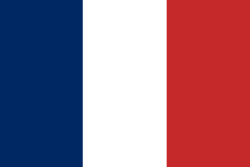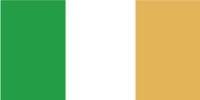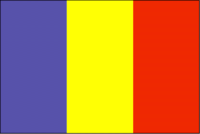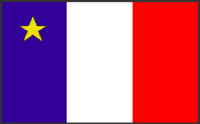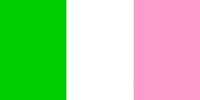Flag of France
|
|
The national flag of France (Vexillological symbol: Missing image
FIAV_56.png
Image:FIAV_56.png
, known in French as le drapeau tricolore, le drapeau bleu-blanc-rouge, le drapeau de la France, rarely, le tricolore and, colloquially, les couleurs) is a tricolour featuring three vertical bands coloured blue (hoist side), white, and red. The national flag of France is known to English speakers as the French tricolor (American English), the French tricolour (British English), or the tricolore.
| Contents |
Design
The red and blue colours of the flag are now officially PANTONE "Reflex Blue" and PANTONE "Red 032", or RGB (0,85,164) and (239,65,53), or CMYK (100,73,0,2) and (0,90,86,0). These were adopted by Valéry Giscard d'Estaing, replacing the previous darker version of the flag.
Currently the flag is 50% longer than its height (i.e. in the proportion 2:3) and, except in the navy, has stripes of equal width. For many years the three stripes of the flag were not equally wide, being in the proportions 30 (blue), 33 (white) and 37 (red), the same proportions as the former flag of Paris. The theory was that if they were equal then the white stripe, being brighter, would appear disproportionately wider to the human eye. This was changed to equal width by Napoléon, although by a regulation dated 17 May 1853 (?), the navy went back to using the 30:33:37 proportions, which they continue to use.
Tricolore_flagpole.mirrored.jpg
History
The origins of the tricolore are said to be a rosette, created in July 1789 during the French Revolution, which (according to legend among vexillologists) used a combination of the colours of the coat of arms of Paris (red and blue) and the royal colour (white), with the combination often being credited to the Marquis de Lafayette. However it is unlikely that this is correct, since by 1789 the colours of Paris were no longer in use; much more probable is that La Fayette just adopted the colours of the American Revolution (blue, red and white). Most historians and specialists of flags, including those in France, agree now with this last version, although the legend predominates.
Originally the flag was often flown with the colour red at the hoist side, but it was standardized as blue on this side when the flag was officially adopted as the national ensign on February 15 1794 during the First Republic, and came into use as such on May 20 of the same year, in order to avoid confusion in naval warfare. Its adoption was not universally welcomed; the navy threatened to mutiny, since they were at the time continuing to fight under the white flag of the monarchy. Even when the three colours had been used - for example by the army in 1791 and by the National Guard after 1789 - they were often used creatively. For example, at the Battle of Arcole Napoleon brandished a white standard, with a golden fasces lictoriae in the center (a symbol of the former Roman Republic), and four red and blue lozenges at the corners. The vertical striped flag was adopted by the army in 1812, replacing the previous flags which were often a white cross on red and blue.
After the restoration of the Bourbon monarchy following the defeat of Napoleon in 1815 the tricolore was replaced by the royal white standard with fleur-de-lis which had been in use before the Revolution. However, the revolution of 1830 saw Louis-Philippe, the Citizen-King, ascend to the throne who again designated the tricolore as the national flag, which it has remained ever since.
Flag_of_Free_France_1940-1944.gif
During the Revolution of 1848, the red flag was raised by radicals supporting a socialist alternative government to the new French Second Republic while moderates rallied to the tricolore.
In World War II, Vichy France continued to use the traditional French standard. To distinguish themselves, Free French Forces under Charles de Gaulle bore a Tricolore with a red Cross of Lorraine superimposed in the centre.
Influence
The flag of France represented a new revolutionary movement; as such, it influenced many other flags, including those of Belgium, Chad, Ireland, Italy, Mexico and Romania. The flag of the Acadians was based on the French flag.
Current flags
Historic flags
| National flags |
| List of national flags | List of national coats of arms |
See also
External link
ast:Bandera de Francia ca:Bandera de França de:Flagge Frankreichs et:Prantsuse lipp es:Bandera de Francia fr:Drapeau de la France it:Bandiera francese he:דגל צרפת ja:フランスの国旗 ko:프랑스 국기 lb:Fändel vu Frankräich pl:Flaga Francji nl:Tricolore pt:Bandeira da França ro:Steagul Franţei sv:Frankrikes flagga zh:法国国旗

